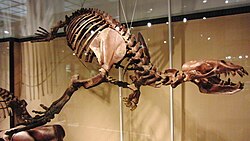Vertebrates
Cartilaginous fishes
Sharks

- †Alopias exigua [1]
- †Alopias latidens [1]
- Alopias vulpinus' [1]
- †Carcharocles angustidens ' [1]
- †Carcharodon hastalis' [1]
- Carcharhinus sp.' [1]
- Cephaloscyllium sp.' [1]
- Cetorhinus sp.' [1]
- Echinorhinus blakei' [1]
- †Galeocerdo medius' [1]
- †Galeorhinus latus' [1]
- Heterodontus sp. [1]
- Hexanchus sp. [1]
- †Megachasma applegatei [2]
- †Megalolamna paradoxodon [3]
- †Negaprion elongata' [1]
- Odontaspis ferox' [1]
- †Parotodus benedini' [1]
- Sphyrna sp.' [1]
- †Squalus serriculus' [1]
- Squatina lerichi' [1]
Rays and skates

Bony Fishes

- Bothidae indet. [1]
- Embiotocidae indet. [1]
- Gadidae indet. [1]
- Pleuronectidae indet. [1]
- Sciaenidae indet. [1]
- Scorpaenidae indet. [1]
Reptiles
- Chelonia indet. [1]
- Crocodylia indet. [1]
- † Psephophorus calvertensis [1]
Birds
Mammals

- † Allodesmus kernensis [4]
- † Allodelphis pratti [4]
- †Amphidelphis bakersfieldensis [4]
- † Anchitherium sp. [1]
- † Argyrocetus joaquinensis [4]
- † Desmathyus [1]
- †Enaliarctidae indet. [1]
- † Enaliarctos mealsi [1]
- † Macrodelphinus kelloggi [4]
- † Miodelphis californicus [4]
- Otariidae indet. [4]
- Phocidae indet. [4]
- Pinnipedia indet. [1]
- † Pinnarctidion bishopi
- †Squalodontidae indet. [1]


